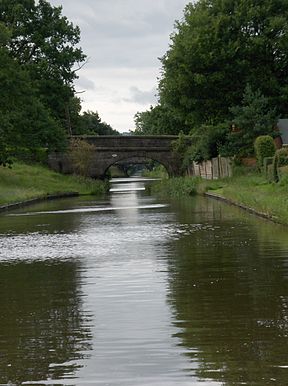
Back قناة ماكليسفيلد ARZ Macclesfield Canal CEB Canal de Macclesfield French Маклсфилд (канал) Russian Macclesfield Canal Swedish
| Macclesfield Canal | |||||
|---|---|---|---|---|---|
 The canal near Congleton | |||||
| Specifications | |||||
| Maximum boat length | 70 ft 0 in (21.34 m) | ||||
| Maximum boat beam | 7 ft 0 in (2.13 m) | ||||
| Locks | 13 | ||||
| Status | Navigable | ||||
| Navigation authority | Canal & River Trust | ||||
| History | |||||
| Original owner | Macclesfield Canal Company (est. 1817) | ||||
| Principal engineer | Thomas Telford | ||||
| Other engineer(s) | William Crosley | ||||
| Date of act | 1826 | ||||
| Construction began | 1826 | ||||
| Date completed | 1831 | ||||
| Geography | |||||
| Start point | Marple Junction | ||||
| End point | Hall Green (The final section to Hardings Wood Junction was built as part of the Trent and Mersey Canal) | ||||
| Connects to | Peak Forest Canal Trent and Mersey Canal | ||||
| |||||
The Macclesfield Canal is a canal in east Cheshire, England. There were various proposals for a canal to connect the town of Macclesfield to the national network from 1765 onwards, but it was not until 1824 that a scheme came to fruition. There were already suggestions by that date that a railway would be better, but the committee that had been formed elected for a canal and the engineer Thomas Telford endorsed the decision. The canal as built was a typical Telford canal, constructed using cut and fill, with numerous cuttings and embankments to enable it to follow as straight a course as possible, although Telford had little to do with its construction, which was managed by William Crosley.
The canal opened in 1831 and is 26.1 miles (42.0 km) long. All of its twelve locks are concentrated in a single flight at Bosley, which alters the level by 118 feet (36 m). The canal runs from a junction with the Peak Forest Canal at Marple in the north, in a generally southerly direction, through the towns of Macclesfield and Congleton, to an end-on junction with the Hall Green Branch of the Trent and Mersey Canal. There is a stop lock at the junction, which drops the level by 1 foot (0.30 m), and the branch runs for another 1.5 miles (2.4 km) to Hardings Wood Junction, where it joins the Trent and Mersey main line. This short branch is usually considered to be part of the Macclesfield Canal in modern literature.
Faced with growing threats from railways and the fact that the Trent and Mersey was proposing to merge with a railway company, the management did all they could to cut costs. In 1846, they reached an agreement to sell the canal to a railway company, which became the Manchester, Sheffield and Lincolnshire Railway soon afterwards. Under railway ownership, the canal fared better than many and commercial carrying continued until 1954. There had been some leisure use of the canal since the end of the First World War and the North Cheshire Cruising Club, formed in 1943 and based at the High Lane arm, became the first such cruising club on the British inland waterways. There were dangers that the northern end would be isolated under plans to close the Ashton Canal and the lower Peak Forest Canal in the early 1960s, but vigorous campaigning and a growing restoration movement resulted in the Transport Act 1968, which secured the future of those canals. The designation of the canal as part of the Cheshire Ring in 1965 was part of the strategy by the Inland Waterways Association to promote the leisure potential of canals.
The whole canal was designated as a Conservation Area by Macclesfield Borough Council in 1975 and a large number of its structures have been Grade II listed in recognition of their historic importance. This includes a number of elegant roving bridges, which are known locally as snake bridges. Much of the canal is rural, passing through open countryside, and there are a number of impressive embankments and aqueducts, where the canal crosses river valleys. In the centres of population, there are several large mills that were once served by the canal but are now repurposed as small industrial units or apartments.
